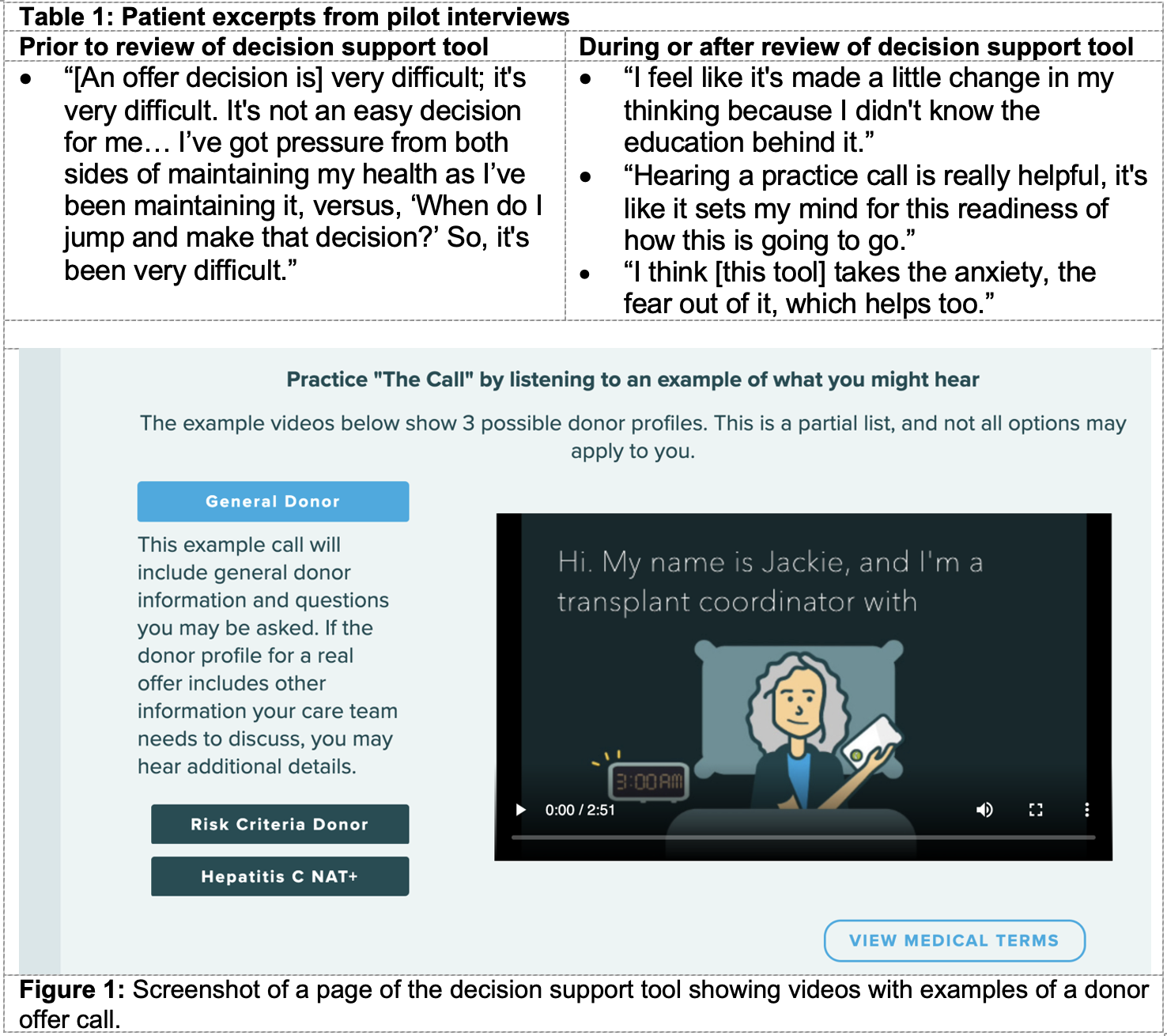A Patient and Family Decision Support Tool for Kidney Organ Offer Decisions
1Hennepin Healthcare Research Institute, Minneapolis, MN, 2Hennepin Healthcare / University of Minnesota, Minneapolis, MN, 3University of Minnesota, Saint Paul, MN
Meeting: 2022 American Transplant Congress
Abstract number: 723
Keywords: Donors, marginal, Patient education
Topic: Clinical Science » Kidney » 32 - Kidney Deceased Donor Selection
Session Information
Session Name: Kidney Deceased Donor Selection
Session Type: Poster Abstract
Date: Saturday, June 4, 2022
Session Time: 5:30pm-7:00pm
 Presentation Time: 5:30pm-7:00pm
Presentation Time: 5:30pm-7:00pm
Location: Hynes Halls C & D
*Purpose: For kidney transplant candidates and their care team, deciding to accept a donor organ with known or potential risk factors can be stressful and can lead to declined offers. Past interventions to support patient decisions have been evaluated during transplant evaluations. This period can be overwhelming and result in low retention and poor understanding of differences in donor quality. We developed a decision support tool, intended to reside on the Scientific Registry of Transplant Recipients (SRTR) website, srtr.org, and used after an initial evaluation and throughout the candidate’s time on the waiting list. The tool includes novel components such as example videos of how an organ offer call may sound [Figure 1] and a donor offer plan to summarize preferences and opportunities for shared decision making. We sought pilot evaluations from kidney transplant candidates to improve the usefulness and relevance of the tool.
*Methods: Pilot interviews with kidney transplant candidates included discussions about perspectives on organ offer decisions and a review of a prototype online decision support tool. Questionnaires collected participant demographics. The website design included a series of sections beginning with general topics about organ donation, donor-recipient matching, donor testing, and waitlist outcomes, concluding with a template to complete an action plan for a future organ offer. Interviews were conducted virtually and audiotaped. Qualitative feedback on graphics, content, and navigation was summarized to inform future iterations.
*Results: Eight transplant candidates participated in pilot interviews for the current development phase. Each interview lasted about 1 hour. Feedback on the graphic style was positive and reinforced the benefit of a patient-friendly aesthetic. Participants had varying views of the offer process before reviewing the tool but consistently reported that the review was beneficial [Table 1]. Preferred dissemination timing was after an evaluation as a periodic review, because preferences may change as waiting time increases. Feedback was incorporated to clarify language and describe additional scenarios such as preemptive listing.
*Conclusions: New decision support tools for offer decisions may address gaps in patient counseling, particularly after evaluations. Stakeholder feedback supports ongoing development of an interactive tool to help patients and family prepare for an offer decision.
To cite this abstract in AMA style:
Schaffhausen C, Hart A, Chu S, Israni AK, Synder J. A Patient and Family Decision Support Tool for Kidney Organ Offer Decisions [abstract]. Am J Transplant. 2022; 22 (suppl 3). https://atcmeetingabstracts.com/abstract/a-patient-and-family-decision-support-tool-for-kidney-organ-offer-decisions/. Accessed December 13, 2025.« Back to 2022 American Transplant Congress

